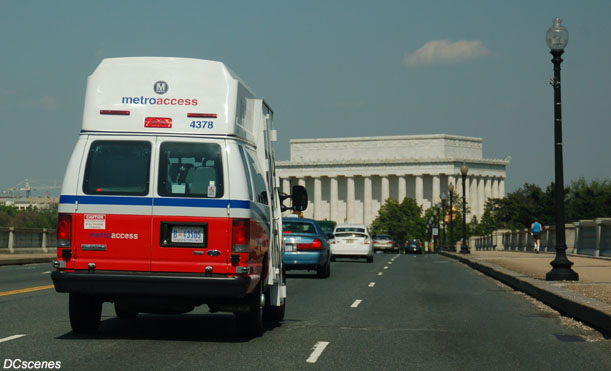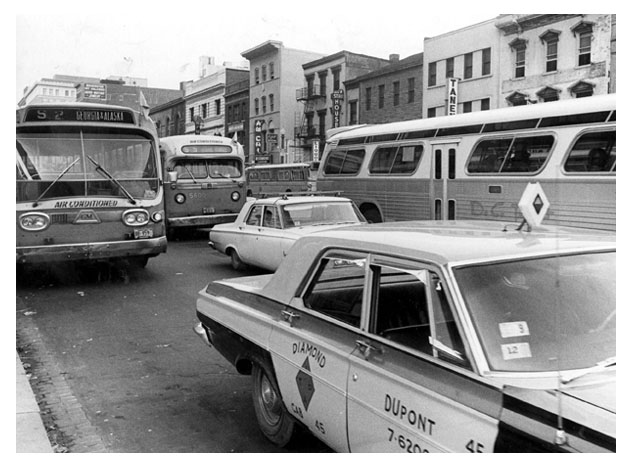Washington, D.C. Bus License Plates
Just about every jurisdiction has a non-passenger type that's particularly suited to the environment in which it's used, and in D.C., bus is that type. As discussed in our statistics section, the nation's capital has a higher concentration of registered buses than any of the states.
We know that special plates were not issued for use on buses when a system of non-passenger letter prefixes was introduced in 1927, which leads us to conclude that distinctive bus plates were not issued prior to that year, either. It is possible that L-prefix Livery plates were used on buses beginning in 1927, but more likely regular commercial plates were issued. By 1934, however, we know that specially-marked bus plates were provided, and separate Sightseeing Bus plates were in use by 1933, as discussed here. Readers are cautioned not to assume that 1927 and later plates with a B prefix were issued exclusively for buses. As discussed in the Commercial section, B-prefix plates were issued for all trucks of a certain weight class. When they appeared on buses it was due to the vehicle's weight, not its body style.
Distinctive license plates for use on school buses are not known to have ever been issued in D.C. Most of these vehicles are owned by the city government and are therefore registered with D.C. Government plates, and privately-owned school buses are registered with regular B-prefix plates.
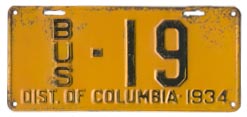
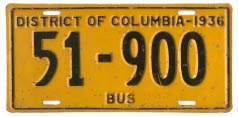
 |
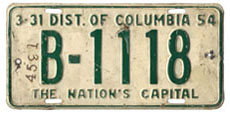 |
1946 |
1953 |
 |
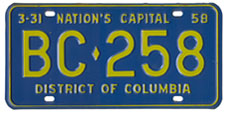 |
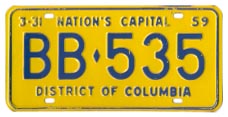 |
1956 |
1957 |
1958 |
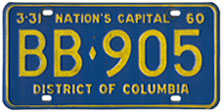 |
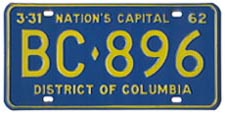 |
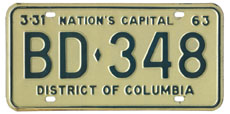 |
1959 |
1961 |
1962 |
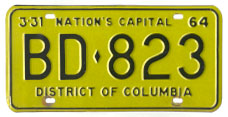 |
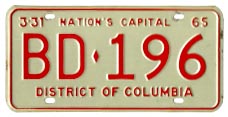 |
1963 |
1964 |
After 17 years (1948-1964) of issuing new plates annually, in early 1965 the D.C. DMV introduced a four-year baseplate for use on busses. These black-on-white plates were revalidated for the 1966, '67, and '68 registration years with a sticker bearing the expiration year (i.e. "67," "68," and "69"). This issuance pattern is similar to that used for truck plates, which is further explained here.
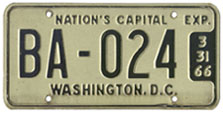 |
 |
1965 |
1966 |
From 1969 (exp. 3-31-70) through 1973 (exp. 3-31-74) new dated plates were issued annually except for that 1965 baseplates used by D.C. Transit were revalidated for the 1969 registration year with "3-31-70" stickers. Aside from that exception, numbers were assigned sequentially from a common starting point for the first four years of this era. For 1973, however, the sequence picked up near where plates of 1972 had ended, which explains the unusually high numbers on 1973 plates of this and certain other types.
 |
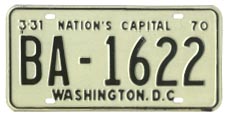 |
1969 for D.C. Transit |
1969 regular |
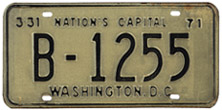 |
 |
1970 |
1971 |
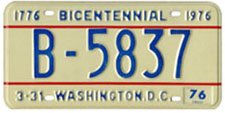 |
1974 Baseplate It is assumed that this baseplate was issued for busses during the same period that it was issued for private passenger vehicles, that being April 1974 through March 1978. We also assume that B-101 was the first number issued because 101 is the known starting point for other types on this base. The highest number observed is B-7120. |
|
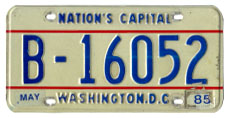 |
1978 Baseplate This base was probably issued only for new registrations from April 1978 through Sept. 1984, as was the case with auto plates of the same design. Only two examples have been observed, nos. B-16052 and B-16202, so both the low and high cutoff points are presently unclear. | |
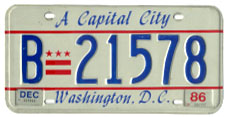 |
1984 Baseplate This base was likely introduced in Oct. 1984, when the design was introduced for passenger car plates, or possibly shortly thereafter. The lowest and highest numbers observed on this base are B-21578 and B-31866. |
|
1984/1993 baseplate cutoff point documentation gap: B-31867 to B-32673 (807 numbers) |
||
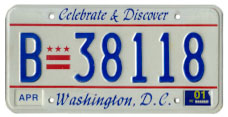 |
1993 Baseplate Although the Celebrate and Discover slogan was introduced for auto plates in mid-1991, it was probably a few more years before all 1984 baseplates could be issued, at which time the change would have been reflected on bus plates. The lowest and highest numbers observed on plates with the slogan at the top are B-32674 and B-38319. |
|
1993/2000 baseplate cutoff point documentation gap: B-38320 to B-38501 (182 numbers) |
||
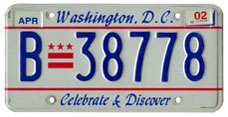 |
2000 Baseplate When the general-issue passenger registration numbering format was changed to AB-1234 in April 1997, the position of the city name and slogan were reversed. This change was introduced to bus plates exactly three years later, creating the 2000 baseplate. The lowest and highest observed numbers of this base are B-38502 and B-40496. | |
2000/2003 baseplate cutoff point documentation gap: B-40497 to B-40517 (21 numbers) |
||
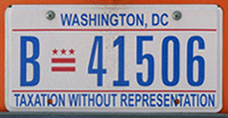 |
2003 Baseplate The first bus plates with the "TAXATION" legend are flat and feature the city name in the font introduced on auto plates in Oct. 2002, so we assume they were issued sometime after that month, presumably when the supply of 1991 baseplates was exhausted. The lowest and highest observed numbers are B-40518 and B-41529. | |
2003/2006 baseplate cutoff point documentation gap: B-41530 to B-42048 (519 numbers) |
||
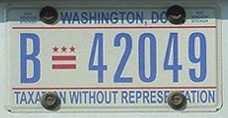 |
2006 Baseplate The appearance of bus plates was changed slightly with the addition of SEE WINDOW STICKER in the upper corners. The lowest and highest observed numbers are B-42049 and B-48851. | |
2006/2014 baseplate cutoff point documentation gap: B-48852 to B-49054 (203 numbers) |
||
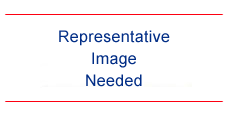 |
2014 Baseplate In mid-2014 bus plates began to be issued with DISTRICT OF COLUMBIA in place of WASHINGTON, D.C. The lowest observed example of this style is B-49055. | |
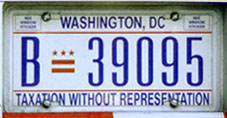 Bus plate B-39095 is an example of a small quantity of non-standard plates observed beginning in 2009 that are procured privately by METRO to replace worn, illegible plates on their vehicles, as well as plates that have been lost. The lowest and highest of the eight examples reported to us are B-37458 and B-40031, numbers that were originally made on different styles of the 1991 Celebrate & Discover base. The most noticeable non-standard characteristic of these plates is the registration number font, which is comprised of characters with a narrower stroke than figures on other D.C. plates. However, upon closer examination (click on the image of plate B-39095 for a closer look), the plate's construction is entirely different than that of standard plates. All of the printed portion appears on a piece of reflective sheeting that has been adhered to a slightly larger, light aluminum plate of the style often used by private companies in the manufacture of booster plates used to advertise vehicle dealers and convey other messages. The manner in which the border is embossed but not painted is a characteristic of booster plates, as is the use of bolt slots, not the holes that are now used on practically all U.S. license plates.
Bus plate B-39095 is an example of a small quantity of non-standard plates observed beginning in 2009 that are procured privately by METRO to replace worn, illegible plates on their vehicles, as well as plates that have been lost. The lowest and highest of the eight examples reported to us are B-37458 and B-40031, numbers that were originally made on different styles of the 1991 Celebrate & Discover base. The most noticeable non-standard characteristic of these plates is the registration number font, which is comprised of characters with a narrower stroke than figures on other D.C. plates. However, upon closer examination (click on the image of plate B-39095 for a closer look), the plate's construction is entirely different than that of standard plates. All of the printed portion appears on a piece of reflective sheeting that has been adhered to a slightly larger, light aluminum plate of the style often used by private companies in the manufacture of booster plates used to advertise vehicle dealers and convey other messages. The manner in which the border is embossed but not painted is a characteristic of booster plates, as is the use of bolt slots, not the holes that are now used on practically all U.S. license plates.
Estimate of Bus Registration Numbers Assigned Annually Since 2009
Approximately 46,200 pairs of bus plates were issued during the 38-year period from 1974 through 2011. If all of them were issued in conjunction with a new registration, there would have been an average of 1,215 new registrations annually during this 38-year period. However, there likely was a complete reissuance of bus plates in the mid-1980s, as there was with passenger car plates. Based upon the relatively small quantity of data that we have about bus plates, we believe that during the 15 most recent years of this period the number of annual new registration transactions has been closer to 800.
Year |
Estimate of Numbers Assigned |
Quantity of Estimated |
2009 |
B-43875 to B-44734 |
860 |
2010 |
B-44735 to B-45664 |
930 |
2011 |
B-45665 to B-46299 |
635 |
|
This page last updated on December 31, 2017 |
 |
|
copyright 2006-2018 Eastern Seaboard Press Information and images on this Web site may not be copied or reproduced in any manner without consent of the owner. For information, send an e-mail to admin@DCplates.net |














